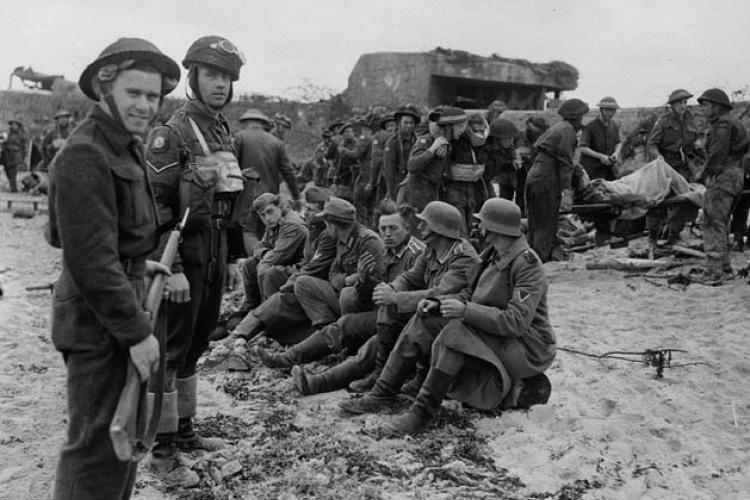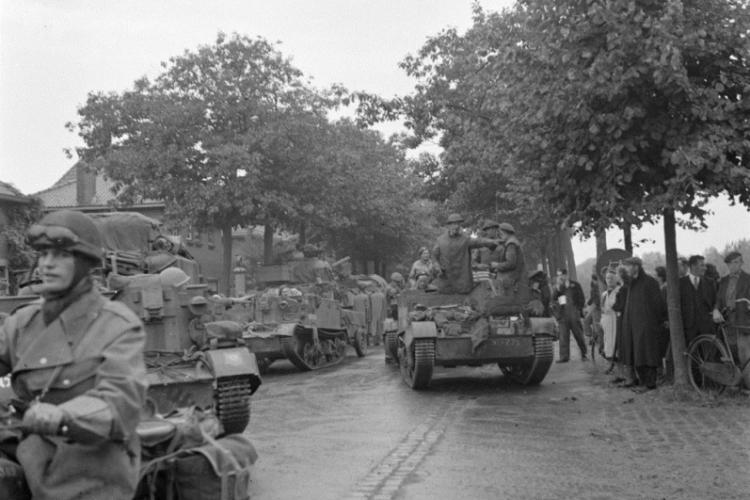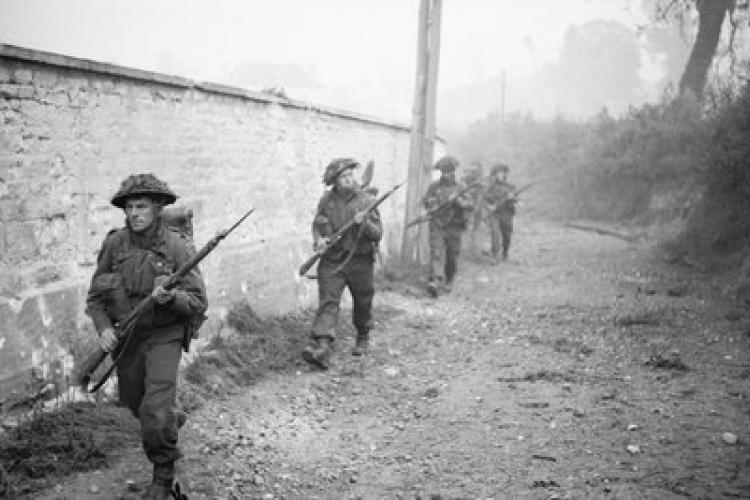Divisional Unit
SERVICE NO: A / 59488
AWARDS: 1939-45 Star, France – Germany Star, War Medal,
Defence Medal and the Canadian Volunteer Service Medal + clasp.
DATE OF BIRTH: February 13, 1920
DATE OF DEATH: April 20, 1945 25 years 1 month
PARENTS: Mr. Charles and Mabel Straughan – Auburn – Ontario.
SISTER: Vivian Elizabeth Straughan – Auburn – Ontario.
CEMETERY: Temporary Cemetery at Friosyothe – Germany to the right of the road
just prior to crossing the bridge into the town. Grave 1.
CEMETERY: Holten Canadian War Cemetery – Holten –
Overijssel – Netherlands.
VI F 2
Grave inscription: “A loved son. He giveth his beloved sleep beyond
the sunset oh, glad reunion”
Height: 5’ 61/2 “ Weight: 175 pounds
Complexion: fair Eyes: blue Hair: fair
Occupation: Farming Religion: United Church
RESIDENCE: Auburn – Ontario.
ENLISTMENT: January 20, 1942 – Kitchener - Ontario
ENLISTMENT AGE: 21 years 11 months.
George received his primary educated and graduated from Grade 8 and then attended high school for two years up until the age of 17. After school he sailed on the lake boats of the Great Lakes for a season before working full time on the family farm in Auburn.
- January 20, 1942 – to No. 10 Basic Training Centre in Kitchener – Ontario.
- March 8, 1942 – to No. 20 Training Centre in Red Deer – Alberta.
- April 9, 1942 – Private Straughan qualifies as Class III Friver of wheeled vehicles.
- April 22, 1942 – to 4th Canadian Armoured Division in Debert – Nova Scotia.
- August 3, 1942 – granted leave until August 16, 1942.
- September 4, 1942 – granted leave until September 12, 1942.
- September 24, 1942 – departed Canadian shores.
- October 8, 1942 – Arrived in Liverpool.
- October 8, 1942 – to Royal Canadian Armoured Corp Training Centre.
- December 10, 1942 – granted leave until December 18, 1942.
- March 29, 1943 – granted leave until April 6, 1943.
- June 21, 1943 – granted leave until July 29, 1943.
- December 26, 1943 – appointed to rank of Lance Corporal.
- January 18, 1944 – completed land mine course.
In the field…..
- July 24, 1944 – Departed England.
- July 28, 1944 – Arrived on the continent in France.
- November 9, 1944 – Taken on Strength with the Argyll and Sutherland Highlands of the Royal Canadian Infantry Corps.
On April 17th, the 4th Canadian Division crossed the canal at Edewechterdamm, eleven miles from Oldenburg. There was however, a very formidable obstacle facing them which was the Kusten Canal with a width of 100 feet.
This a battle that the 4th Canadian Armoured Division which included the Argyll and Sutherland Highlanders of Canada fought between April 17 – 19, 1945.
During the night of April 19th, German radio traffic was intercepted and from this the Division learned that the German High Command considered the Kustan Canal extremely vital and that orders were issued to the German defenders not to retreat at any cost.
The Argylls on the morning of April 20 found the morning to be bright and sunny. They were informed that from intercepted enemy radio traffic they should expect very strong resistance as the enemy felt the canal and area were vital to them. They were also told not to expect an enemy retreat.
Up to this point the German defenders had suffered heavily from the onslaught of Canadian artillery, mortars and aircraft.
On the German side, they felt the Canadian thrust would lead due north to Wilhelmshaven.
Typhoon aircraft had engaged enemy targets shortly before noon and this tied in with attacks by “B & C” Companies as they advanced. By noon they had advanced to the north and it was at this point that things became very sticky. The armour was finding it difficult to move up and provide the necessary support the Argylls immediately needed. In the late afternoon “A & D” Companies also joined the advance and now advancing was slow and it was difficult.
At nightfall on the evening of April 20th, “A” Company had managed to advance to just below the small river separating the Argylls from Osterscheps and it here they met heavy small arms fire and mortar fire. Two of the supporting tanks worked their way forward in support and as they were doing so one tank was knocked out.
The Canadian mortars and artillery were very active into the early night. It was during this advance where Lance Corporal Straughan lost his life in battle.
- On May 5, 1945, the Major – General A. E. Walford per the Adjutant – General wrote the family a letter expressing on the death of Lance Corporal Straughan who died serving his country in the North-West Europe theatre of war.
- On June 29, 1946, a letter was received by the family from Colonel C. L. Laurin Director of Records per Adjutant – General providing detail of the burial of Lance Corporal Straughan at Holten Canadian War Cemetery with the personal invitation to pass along a personal message should the family like to have something on his gravestone.
His personal items were….. 1 kit bag, 1 Kodak Bullet camera, 2 towels, 2 dress caps, 6 handkerchiefs, 1 sleeveless sweater, 1 pair woolen gloves, cap badge / patches, 2 pair socks, 1 pair black oxfords,
1 pair spectacles with case, 2 note books, 1 facecloth, 1 lanyard, 3 souvenir address books, 3 Kodak films, snapshots / negatives.
George’s mother Mabel was the Executrix of his estate. In settling the estate there was $90. In the Bank of Commerce Branch in Auburn, there was a War Savings Certificate in the amount of $10, there were Victory Bonds totalling $500, the War Service Gratuity amounted to $625.37 and his last pay added up to $176.16.



